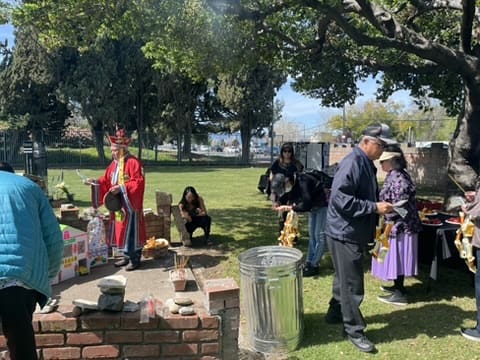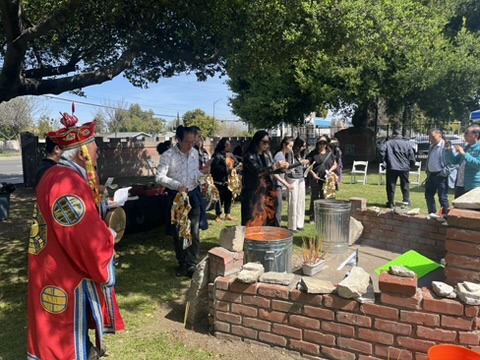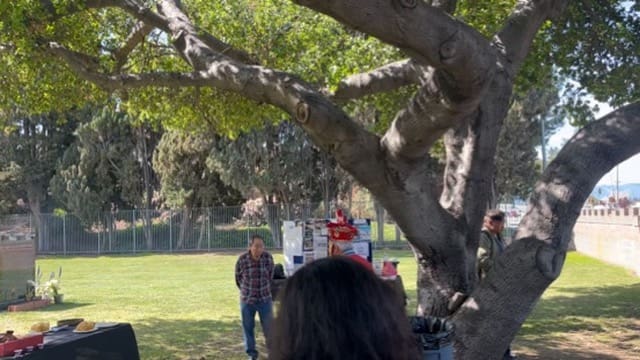Historic Chinese American Cemetery
The Memorial Reads:
南湾歷吏福地

Historic Chinese American Cemetery
In the late 1890s, the Eight Chinese Companies in San Francisco bought the land for the Chinese Cemetery. Before 1950, Chinese Americans were not allowed to be buried in American cemeteries. About 300 pioneers are buried in this 140’ by 160’ plot, and it is believed that most were single or had no relatives in the area. The first burial was Lee Quong Hong on July 24, 1900. The last burial was Lee Chi On on June 15, 1964.
Since 1900, this land has been passed down within the community to those who wish to honor these early pioneers. In 1979, the South Bay Historic Chinese American Cemetery Corporate was established to maintain the land and continue honoring the dead in the annual Ching Ming Jie or Grave Sweeping Day.
Every Spring, they gather as a community to clean the tombstone, burn offerings for the dead, and offer and eat food. A Taoist priest leads a commemoration to those buried, and the community recites their names in remembrance.
Every Spring, they gather as a community to clean the tombstone, burn offerings for the dead, and offer and eat food. A Taoist priest leads a commemoration to those buried, and the community recites their names in remembrance.
History and Establishment

The Chinese Historic Cemetery stands not merely as a place of rest but as a profound testament to the enduring spirit of the Chinese American pioneers. It is a chronicle of both sorrow and strength, a place where the whispers of the past echo with tales of struggle, hope, and unity.
In an era shadowed by exclusion, the Chinese American community faced barriers that extended beyond the realm of the living, into the silence of death itself. Denied a place in “American” cemeteries, they were thrust into the margins, their existence marginalized even in death.
Notable or Famous People Buried:
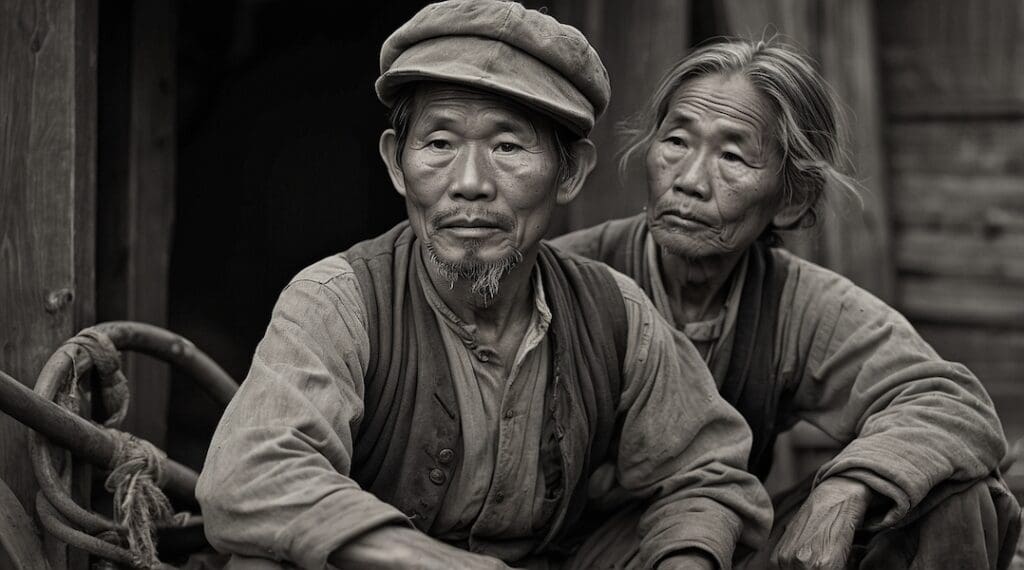


These souls, many of whom journeyed through life solitary or severed from their kin, found a place of eternal rest among their community in San Jose, California. From Lee Quong Hong, whose passage into eternity on July 24, 1900, marked the beginning of this sacred trust, to Lee Chi On, whose burial on June 15, 1964, closed a chapter yet left an indelible mark on the tapestry of memory.
While there may not be well-known “famous” figures like those in other famous cemeteries, many of the individuals buried here played significant roles in the development of San Jose and the surrounding areas. Early Chinese immigrants were critical to the agricultural economy, particularly in farming, railroad construction, and trade. Many of the people buried at this cemetery were part of the working-class Chinese community, including laborers, merchants, and farmers who made significant contributions to local development.
One of the most notable individuals interred here was Tung Hing, a successful merchant in San Jose who was active in helping establish the cemetery. He was part of a group of Chinese American leaders who ensured that there was a final resting place for their community in a time of discrimination.

Acquisition of the Property
A parcel of land, granted by Oak Hill Cemetery in 1900 to the 8 Chinese Companies in San Francisco, California, emerged as a sanctuary for those who had been voiceless.
This modest plot, measuring 140 by 160 feet, became the final haven for approximately 300 pioneers.
Names Engraved in Remembrance
| Historic Chinese American Cemetery | ||||||||||
| Chu Lee | Ah Yun | Ah Sun | Lee Ken | Ung She | Lee Kang Sing | |||||
| Wong Wong or Fung Joe | Lee Kee | Ah Leon | Loy Choy Sing | Chung Sho | Chin Hoo (infant) | |||||
| Chung Sho | Kim Fung | Ah Sing | Long Fong | Yong Why | Fong Gee | |||||
| Le Gong | Le Hi Wah | Lo Di Fouk | Loy Soy Sing | Leon Kom | Lo Ki Jonk | |||||
| Lew Sin | Sing Look | Hong Wong | Leang Cheow | Yip Lund Lun | Lee Sing Chuk | |||||
| Ah Leong Ng | Infant of Leo Chow | Dang Wan | Ling Jung | Dong Sing Soon | Jung Lee | |||||
| Young Lin | Gin Gunn Moon | Ye Ah Lung | Woo Hing | Infant of Chin Hung Lee | Kim Song | |||||
| Jim Hay Leong | Go Gin | Lee Chon | Low Gee | Jue Bon | Infant of Chun Hong Gon | |||||
| Ah Wing | Chin Gow Wuh | Gee Wing Po | Sang Chung Lee (Lee Gee interred) | Chin Let | Jue Hock Ng | |||||
| Lom Kum Los | Ching Low | Lee Hong | Tung Shang | Lillie J. Chow | Wong Jat | |||||
| Jung Gan | Chin Jew | Ah Sing or Hong Sing | Gey Quay | Gee Ping | Lee Young | |||||
| How Ng | Ie How Ng | Toy Fong | Chin Ah Mow | Chin Chow | Ah Fook | |||||
| Tom Jung | Lee Yin | Ng Yong Pong Sing | Lee Yin | Chin Francis | Chey Goo (Sing Leang interred) | |||||
| Jew Ming Bow | Oon Mun | Leong Chong | Choy Edward | Wing Gee | Ng May | |||||
| Ng Pok | Lin Ng | Chin Jew | Ida. Com Oye Kee | Ng Pay | Nu Hai | |||||
| Lee Chung | Lin Fook How | Wong Yip Gein | Chung Ying Poo | Chin Keong | Chin Con | |||||
| Say You | Ying Ming Lum | Jue Do | Chin Dew | Hing Hay Yee | Weh Hong | |||||
| Hong Wey | Ng Ki Hong | Ah Fung | Bing Fook | Yong Kuk | Lee Jew (interred Lim How Kam) | |||||
| Fue Ah | Duck Wong | Lee L Gee | Sai Lin Wong | Joe How | Wong Sam | |||||
| Wong Hock Young | You Toy | Hong Wong Ung | Chin Fluck | Suey Pong | Lee Lung Quong | |||||
| Yee Plu Ng | Ah Kum | Kong How | Chin Poy | Lew Hang | How Kam Lim | |||||
| Chow Leong | Gee Wong Ying | Ah Woon | See Kun | Duck Ng | Hoy James | |||||
| Wing Jung Ng | Long Kue | Hao Tung | Wong Wing | Lee Sue Bin | Leong Lin Sing | |||||
| See Yen | Wong Chin | Chin Tung Lung | Jo Leng Sing | Lim Gow | Ah Kum (interred Ah Heim) | |||||
| Lee Wau | Dong Foon | Lee Jung | Soo Ho Tai | Jue Yu | Yu Gue | |||||
| Chan Dan | Lee Soon | Ku Gubg Yung | Ku Gubg Yung | Quong Low | Infant of Kee Chow | |||||
| Sin Din Wah | Lee Sing | Lee Chung | Chan Snow | Li Soon Toy | Gung Yum | |||||
| Chew Suy Jung | Chew Hing Bam | Yi[ Rue Yu | Lim Toy | Fook Gee | Chin Soon | |||||
| Hong Wong | Chi Hong | Lee Luey Wong | Chew Ah Gans | Tong Chuck | Ng Woo | |||||
| Lee Mon Quong | Duck Yee | Lew Chin | Wong Bo | Qumm Pang Wong | Sam Ywe Jew | |||||
| Ah Ling | Lung Go | Yet Gown Yong | Ching Lung | Wong Gee | Infant of Ng. & Lee Tom | |||||
| E.H. Long | Lee Yin | Lew Chaw | Wong Yu | Le Hangme | Kim Foo | |||||
| Lee Yin | Ark Yuen Wang | Loo San | Young Hung | Lee Quang Duck | Ah Sing | |||||
| Lee Chung | How Yee | Lee Kah | Lee Fong | Good Oy Chin | Mrs. Ah Toy | |||||
| Ah Shin | See Lin | Qui Lum | Toy Wong | Tom Fong | Long Chueng | |||||
| Ng Goon | Ha King Wah | Chin Ling | Mar Quey | Oh Fee Hung | Inoch Chew | |||||
| Ng Long You | Lee Shee | Jim Wue | Chin | Ling Six | Chow Wing | |||||
| Lee Long Tom | Sam Kee | Lee Tom | Yen Kee Tom | Ching Jung | Chew Loy | |||||
| Ng Yuen | Lem Soo | Chew Waly | Young To | Ching Quong Gin | Long Mow Hong | |||||
| Infant Ng | Chew Waey | Ah Sing | Quong Him | Long Chew | Infant Chin Wee | |||||
| Anna Mock | Jach Chinn | Mary Chen | Lee Yan | Woo Hing | Willis Jeong or Lay Jeong | |||||
| Wong Yon | Ah Ho | Sai Yun | Ng Chung | Wong Sung | Ching Yang Yoon | |||||
| Ah Joe Chew | Yee Ming | Yeong Kee | Alan Wong | Chew Yook | Swen Chew Yung | |||||
| Sing Ching | Won Onn | Yum Chung | Wong Yee | Yee Yen | Choi Quang Sung | |||||
| Leong Ah Way | Wai Leong | Chaues Moy | Leung Ung | Lee Chi On | Yuk Kay Yee | |||||
Ching Ming Jie
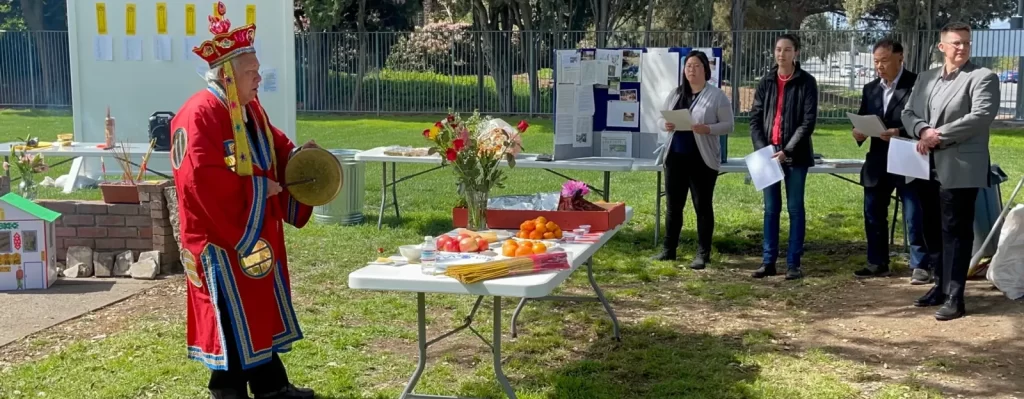
The annual Ching Ming Jie, or Grave Sweeping Day, transforms this place of rest into a vibrant tableau of life, memory, and communal bonds. On the 15th day after the Spring Equinox, the air is filled with the melody of reverence and remembrance, as the community gathers to pay homage to their ancestors. This ritual, steeped in tradition, weaves a tapestry of continuity, linking the past with the present, and bequeathing its rich legacy to future generations.
The Chinese Historic Cemetery stands as a monument to the resilience, courage, and unity of the Chinese American pioneers. It is a place where silence speaks volumes, where every stone and every name etched upon it tells a story of perseverance in the face of adversity. As we walk among these markers, we are reminded of the indomitable spirit of those who laid the foundations of our community with their dreams and their toil. In honoring their memory, we reaffirm our commitment to the values of dignity, respect, and inclusivity, ensuring that the legacy of these pioneers will continue to inspire generations to come.















